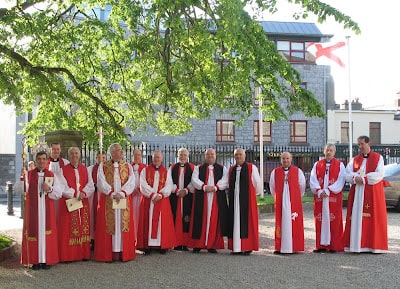No products in the cart.
Return To Shop
What is a Clergy Chimere?
The clergy chimere, an iconic vestment in ecclesiastical attire, holds a significant place in the world of religious symbolism and tradition. This unique garment has a rich history and plays a crucial role in various religious ceremonies. In this article, we delve into the origins, purpose, and symbolism of the clergy chimere, exploring its place in modern times while preserving age-old traditions.
Understanding the Clergy Chimere
Definition of a Clergy Chimere
The clergy chimere is a ceremonial robe or cloak worn by clergy members, particularly within Christian denominations. This ankle-length garment is characterized by its flowing, loose-fitting design and distinct liturgical colors, often adorned with decorative elements. For mens Shop Here!
Historical Significance
The origins of the clergy chimere can be traced back to medieval times when religious vestments began to take on more symbolic meanings. Initially, chimeres were simpler in design, but over the centuries, they evolved into elaborate and ornate garments symbolizing religious authority and dignity.
Symbolism and Design
The design of the clergy chimere often incorporates liturgical colors that hold specific meanings. For instance, white symbolizes purity and celebration, red signifies the Holy Spirit and sacrifice, and purple represents penance and preparation. For mens Shop Here!
The Purpose of the Clergy Chimere
Liturgical Functions
During religious services and ceremonies, clergy members wear the chimere as a representation of their role and responsibility within the church. It serves as a visual marker of their spiritual authority and dedication to their congregation. For womens Shop Here!
Ceremonial Use
Chimeres are commonly worn during special occasions, such as weddings, funerals, and ordinations. The garment adds a sense of solemnity and grandeur to these significant events, enhancing the religious experience for both participants and observers.
Role in Religious Rituals
The chimere plays a role in various religious rituals, signifying the transition between different liturgical acts. Its presence adds a sense of continuity and tradition to the proceedings, connecting the contemporary practice with historical roots.
Types of Clergy Chimeres
Traditional Chimeres
Traditional chimeres adhere closely to historical designs and are often made with opulent fabrics and intricate embroidery. They are favoured by conservative religious institutions and are seen as a link to the past.
Contemporary Chimeres
In contrast, contemporary chimeres may incorporate modern elements while still adhering to traditional patterns. These variations often allow for greater personal expression and comfort without compromising the garment’s symbolic significance.
Regional Variations
Different cultures and religious denominations may have their unique styles of clergy chimeres, incorporating regional motifs and customs. These variations highlight the diversity and adaptability of religious traditions across the globe. For mens Shop Here!
Crafting a Clergy Chimere
Materials Used
The crafting of a clergy chimere requires meticulous attention to detail. High-quality fabrics such as silk, velvet, or brocade are commonly used, ensuring both durability and aesthetic appeal.
Artistic Embellishments
Skilled artisans often embellish chimeres with intricate embroidery, appliqué, or handwoven designs, adding further symbolism and beauty to the garment.
Tailoring and Fitting
Chimeres are tailored to fit each individual wearer, ensuring comfort and ease of movement during religious services and ceremonies.
Iconic Chimere Wearers
Influential Religious Figures
Throughout history, influential religious figures have donned chimeres during their religious duties. The legacy of these leaders adds to the reverence and significance of the garment.
Chimeres in Popular Culture
The clergy chimere has not been confined to religious settings alone; it has made appearances in popular culture, often depicted in movies, television shows, and art, further solidifying its iconic status. For mens Shop Here!
The Clergy Chimere in Modern Times
Continuation of Tradition
Despite the changing times, many religious institutions maintain the tradition of wearing chimeres, upholding their historical and symbolic value.
Adaptation to Contemporary Worship
Some modern religious communities have adapted the chimere’s design and usage to align with their contemporary values while still preserving the essence of tradition.
Controversies and Criticisms
Opinions on Luxury
Critics argue that elaborate chimeres may contradict the principles of humility and modesty preached by some religious traditions.
Practicality Concerns
Practicality concerns have been raised, suggesting that the chimere might be cumbersome and impractical for certain tasks during religious services.
Social and Cultural Debates
The chimere’s relevance in today’s society has sparked discussions about the intersection of tradition and modernity within religious practices.
Perceptions and Symbolism
Perception among the Faithful
The faithful often perceive clergy members wearing chimeres as authoritative figures representing divine guidance and wisdom.
Symbolic Representations
The chimere’s colors, designs, and rituals associated with its usage hold symbolic representations that resonate with the religious community.
Preservation of Tradition
Importance of Cultural Heritage
Preserving the tradition of wearing chimeres is essential for safeguarding the cultural and religious heritage of various communities.
Challenges in Modern Society
Amidst the fast-paced changes in modern society, religious institutions face challenges in maintaining age-old traditions.
The clergy chimere stands as a timeless emblem of religious authority, tradition, and symbolism. Throughout history, this garment has adorned the shoulders of spiritual leaders, guiding the faithful and marking significant religious occasions. While controversies and debates surround its usage, the chimere remains an integral part of religious practices, bridging the gap between the past and the present.









Add comment
You must be logged in to post a comment.